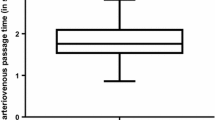Summary
Effects of STA-MCA anastomosis on two patients with neovascular glaucoma due to occlusion of the internal carotid artery are presented. Both patients improved in visual acuity and central retinal artery pressure as well as in signs of transient ischaemic attack. Postoperative angiography showed a marked decrease in collateral flow through the ophthalmic artery, which is reversed from the normal direction, with the development of blood flow through the anastomosis. Discussion is offered indicating that the lack of collateral flow through both the anterior and posterior communicating arteries is important in addition to occlusion of the internal carotid artery in order to produce full-blown ischaemic oculopathy such as venous stasis retinopathy, neovascular glaucoma or rubeosis iridis. It is stressed that EC-IC bypass surgery should be performed soon after the appearance of ischaemia and before the development of neovascular glaucoma or rubeosis iridis in order to obtain normal vision. In ischaemic oculopathy the results of EC-IC bypass can be evaluated objectively and quantitatively by many noninvasive neuro-ophthalmological tests which are important in discussing the efficacy of the bypass surgery.
Similar content being viewed by others
References
Ausman JI, Lindsay W, Ramsay RC, Chou SM (1978) Ipsilateral subclavian to external carotid and STA-MCA bypass for retinal ischemia. Surg Neurol 9: 5–8
Carter JE (1985) Chronic ocular ischemia and carotid vascular disease. Stroke 16: 721–728
The EC-IC bypass study group (1985) Failure of extracranial-intracranial arterial bypass to reduce the risk of ischemic stroke. Results of an international randomized trial. NEJM 313: 1191–1200
Edwards MS, Chater NL, Stanley JA (1980) Reversal of chronic ocular ischemia by extracranial-intracranial artery bypass: Case report. Neurosurgery 7: 480–483
Fisher CM (1959) Observations of the fundus oculi in transient mono-ocular blindness. Neurology (Minneap) 9: 333–347
Gado M, Marshall J (1971) Clinico-radiological study of collateral circulation after internal carotid and middle cerebral occlusion. J Neurol Neurosurg Psychiatry 34: 163–170
Hedges Jr TR (1962) Ophthalmoscopic findings in internal carotid artery occlusion. Bull Johns Hopkins Hosp 111: 89–96
Hollenhorst RW (1961) Significance of bright plaques in the retinal arterioles. JAMA 178: 23–29
Huckman MS, Haas J (1972) Reversed flow through the ophthalmic artery as a cause of rubeosis iridis. Am J Ophthalmol 74: 1094–1099
Kearns TP, Hollenhorst RW (1963) Venous stasis retinopathy of occlusive disease of the carotid artery. Proc Staff Meeting Mayo Clinic 38: 304–312
Kearns TP, Siekert RG, Sundt Jr TM (1979) The ocular aspects of bypass surgery of the carotid artery. Mayo Clin Proc 54: 3–11
Kiser WD, Gonder J, Magargal LE, Sanborn GE, Simeone F (1983) Recovery of vision following treatment of the ocular ischemic syndrome. Ann Ophthalmol 15: 305–310
Mehdorn HM, Nau H-E, Forster M (1986) Carotid artery occlusion and ocular ischemia: Therapy control with evoked potentials. Neurosurgery 19: 1031–1034
Nishikawa N, Nakagawa S, Fujimoto T, Yamamoto Y, Ishimoto I (1981) The influence of the ocular circulation by STA-MCA anastomosis. Clin Ophthalmol (Jpn) 75: 918–921
Standefer M, Little JR, Tomsak R, Furlan AJ, Zegarra H, Williams G (1985) Improvement in the retinal circulation after superficial temporal to middle cerebral artery bypass. Neurosurgery 16: 525–529
Sundt Jr TM, Siekert RG, Piepgras DG, Shabrough FW, Houser OW (1976) Bypass surgery for vascular disease of the carotid system. Mayo Clin Proc 51: 677–692
Young LH, Appen RE (1981) Ischemic oculopathy: A manifestation of carotid artery disease. Arch Neurol 38: 358–361
Author information
Authors and Affiliations
Rights and permissions
About this article
Cite this article
Shibuya, M., Suzuki, Y., Takayasu, M. et al. Effects of STA-MCA anastomosis for ischaemic oculopathy due to occlusion of the internal carotid artery. Acta neurochir 103, 71–75 (1990). https://doi.org/10.1007/BF01420195
Issue Date:
DOI: https://doi.org/10.1007/BF01420195




